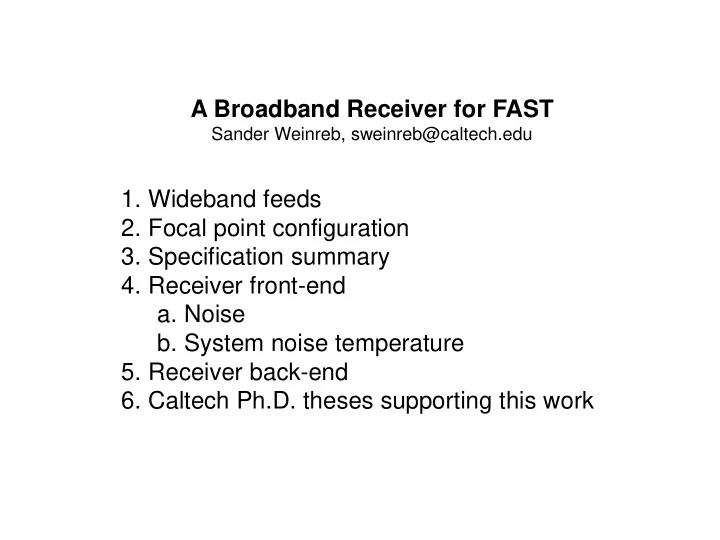

A Broadband Receiver for FAST Sander Weinreb, sweinreb@caltech.edu 1. Wideband feeds 2. Focal point configuration 3. Specification summary 4. Receiver front-end a. Noise b. System noise temperature 5. Receiver back-end 6. Caltech Ph.D. theses supporting this work
Wideband Antenna Feeds Ahmet Agiray Ph.D. thesis at http://radiometer.caltech.edu or IEEE AP • Quad-Ridge Flared Horn (QRFH) antenna feeds cover 6:1 frequency ranges and have been designed and tested on several antennas with varying F/D illumination angles and giving ~ 60% efficiency • The feed can be scaled to for different 6:1 ranges. A 10cm diameter feed cover 4 to 24 GHz (SKA?) and a 1.5m diameter would cover 0.27 to 1.62 GHz (FAST) • Patterns are fairly constant as required for an efficient feed for a parabolic reflector. • Square implementations are easier to fabricate for low frequencies. 21-May-14 Weinreb Jansky 2013 2
Mounting of Broadband Feed and Receiver at FAST Focal Region Focus Cabin 0.27 – 1.6 GHz Receiver Goes Here Feed 1.45m Square Feed and Receiver Not to Scale
Proposed 0.27 to 1.62GHz Receiver for FAST Start June 2014, Complete June 2016 Design, Fabricate, and Test Receiver at Caltech Deliver Designs to NAOC with Option to Deliver Hardware 1) Feed Aperture Efficiency - Greater than 60% for illumination of a F/D=0.461 ideal parabolic reflector. 2) Feed Spillover Noise - Less than 10K noise from 300K radiation outside of 64 degree angle subtended by the reflector in the 0.5 to 1.62 GHz range; less than 15K in the 0.27 to 0.5 GHz range. 3) Noise Goals at 1.42 GHz LNA Noise - 4K Noise at Dewar Input Coax – 13K Noise at Feed Aperture - 20K Tsys - 35K 4) LNA Gain Compression, P1dB - > -39dBm referred to input 5) Noise Calibration Signal - 20 +/- 5K 6) System Mass - < 100 kg excluding cryogenic compressor 7) Feed Size - 1.45m square x 1.2m long
FAST Front-End
New SiGe Cryogenic LNA. LF3, for FAST 0.27 – 1.62 GHz Receiver Performance Summary, 2V, 13mA Bias Parameter At 24K Noise Temperature <5.5 K Gain =20log|S21| 36 +/-2 dB IRL=-20log|S11| >10 ORL=-20log|S22| >14 Gain Compression, Output -5 dBm P1dB Gain Compression, Input -41 dBm P1dB Input P1dB at 2.5V Supply -39 dBm Maximum Power Output +3 dBm = .002W
Cryogenic High-Pass Filter* Loss of 0.15 dB at 300K is expected to decrease at 20K and, as is, would only add 0.7K to receiver noise. The filter provides 43dB attenuation in the FM band at 95 MHz *Design and measurement for cryogenic cooled HPF with 250MHz cutoff frequency Liu Hongfei and Sander Weinreb September 4 2013 http://radiometer.caltech.edu
Components Other Than LNA Determine System Noise LNA and LNA at LNA at Component Remarks Feed at 300K 20K 20K LNA measured at LNA 33 4 4 connector Background + Sky 4 4 4 atmosphere Spillover & Reduce with offset 10 10 4 Blockage antenna Feed loss 7 7 0 Estimate 20cm of 1cm diameter LNA to feed loss 0 4 0 foamed coax, .04 dB Glass/Kovar bead, 0.05 Vacuum feedthru 0 3 2 dB Pre-LNA RFI 0.1 dB Loss 7 0 0 Filter Calibration coupler 7 0 0 0.1 dB Loss 10cm or .141 SS/BeCu Coax in dewar 0 3 0 .09 dB at 190K Total 68 35 20 Estimate, +/- 5K S. Weinreb, Jun 2009 9
FAST Receiver Back-End
Caltech EE Ph.D. Theses on Instrumentation for Radio Astronomy, 2003-2013 Thesis links at http://radiometer.caltech.edu Matthew Morgan – Millimeter-Wave MMICs and Applications, 2003 Mixers, multipliers, LNA’s, switches, and multi-chip modules Joseph Bardin - Silicon-Germanium Heterojunction Bipolar Transistors For Extremely Low-Noise Applications, 2009 SiGe transistor theory, modeling, cryogenic tests, amplifiers Glenn Jones - Instrumentation for Wide Bandwidth Radio Astronomy, 2009 Radio telescope system tests, spectral lines, pulsars, and RFI mitigation Damon Russell - Technology Advances for Radio Astronomy, 2012 Cryogenic wafer probe station, noise parameters, SiGe MMIC designs Ahmed Akgiray - New Technologies Driving Decade-bandwidth Radio Astronomy: Quadruple-Ridged Flared Horn & Compound-Semiconductor LNAs, 2013, 6:1 bandwidth feeds, 1-20 and 3-50 GHz HEMT LNA’s Support Staff : Steve Smith, Research Engineer, Hector Naverette, Technician
Recommend
More recommend